ecommerce website in the Philippines: 7 Proven Tips
June 16, 2025
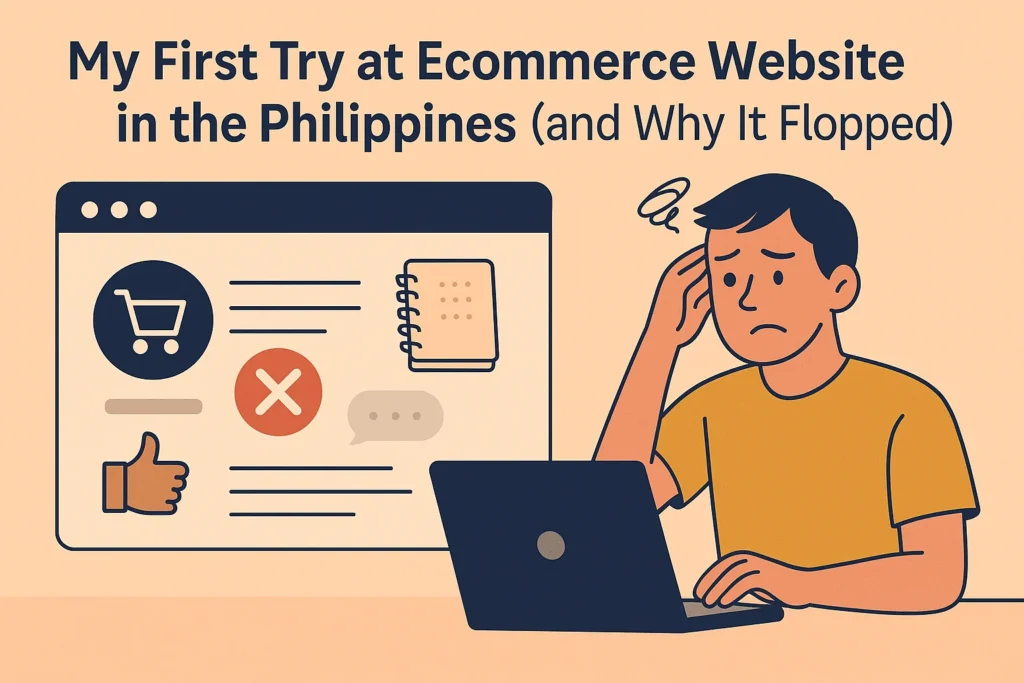
Table of Contents
“By 2025, the e-commerce market in the Philippines is projected to reach over $24 billion.”
Let that sink in.
If you’re running a small business in Cebu, Davao, Manila—or even from your home office in Leyte—this is your sign. There’s never been a better time to build your own ecommerce website in the Philippines and start selling online.
Why? Because Filipinos are buying everything from pet supplies to plants to pan de sal—online. And the platforms are more affordable and accessible than ever.
My first try at ecommerce website in the Philippines (and why it flopped)
I’ll be honest. My first shot at online store development in the Philippines was a mess.
Back in 2020, I tried launching a small online store selling handmade notebooks. I figured, “I’ll just set up a Facebook page and start posting.” It worked for a few weeks… until it didn’t. Orders stopped. Payments got messy. Tracking became a nightmare.
What I didn’t realize was that a Facebook page is not a real ecommerce website. It’s a support tool—but it’s not where the magic happens when it comes to ecommerce websites in the Philippines.
I needed a proper platform that could do more than show pretty pictures. I needed automation. I needed to look legit. Most of all, I needed to make my life easier and take my ecommerce website seriously if I wanted it to grow.
What really hit me was when someone messaged me at midnight, asking if a notebook was still available and how to pay. I had no system. I was scrolling through chats, checking GCash screenshots, and trying to remember if I had already shipped the item. I felt like I was running a business in my head—with no tools to back me up. This was not how online store development in the Philippines was supposed to go.
I remember one order in particular. A customer ordered three notebooks, paid, and messaged me their shipping info. A week later, they messaged again—”Where’s my order po?” I checked my list… and realized I never wrote it down. That was the moment I knew—I couldn’t keep running things like this. I needed a proper ecommerce website in the Philippines to keep things organized.
So I did my research. I started reading about ecommerce websites in the Philippines, comparing tools like Shopify, WooCommerce, and even local platforms. I watched tutorials late at night while packing orders. I slowly rebuilt my store—this time, with structure and purpose.
I launched my new ecommerce website on WordPress with WooCommerce. I set up product pages, added stock quantities, and connected it to a payment gateway. For the first time, people could place an order, pay instantly, and get a confirmation email—all without messaging me. That felt like freedom.
What surprised me most? Sales actually improved. I thought people wouldn’t bother using a website, but turns out, buyers like the simplicity. They want to browse at their own pace, not wait for you to reply. And because my ecommerce website in the Philippines looked more professional, customers started sharing it with friends.
The best part? I could sleep without checking my phone every hour. Orders were automated. No more lost messages or duplicate shipping. The site did the hard work.
Looking back, I wish I hadn’t waited so long. If you’re a small business owner thinking of launching an ecommerce website in the Philippines, learn from my mistake. Don’t rely on social media alone. Use it to support your store, not run it.
If you’re serious about selling online—especially in places like Cebu where digital businesses are growing fast—you need an ecommerce website that does the work for you. It’s not just about looking good. It’s about making sales, saving time, and building something that lasts.
Why small businesses in PH need an ecommerce website
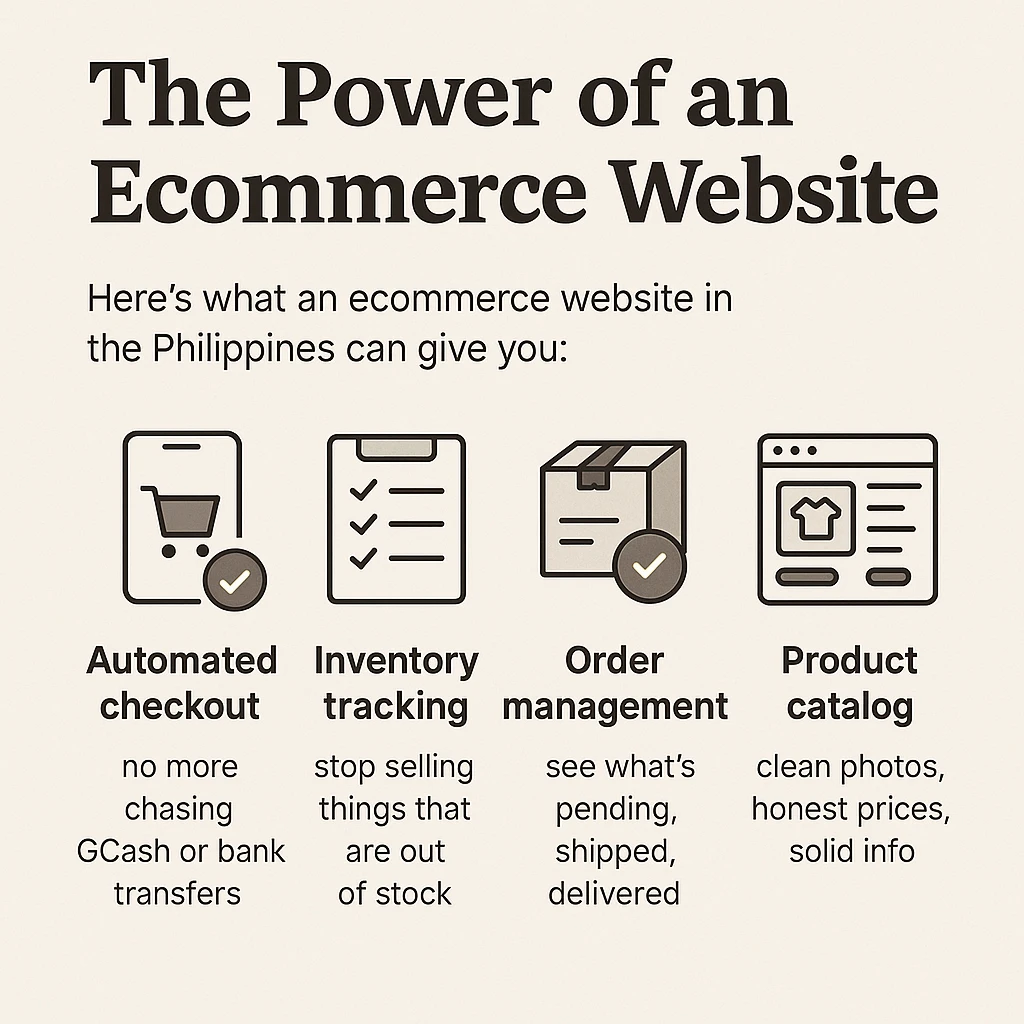
Let“More than 76 million Filipinos are internet users, and 71% have shopped online at least once.” That’s a massive market waiting for your product.
Let’s say you’re selling coffee beans from Bukidnon or artisanal soap in Cebu. Without an ecommerce website in the Philippines, you’re basically whispering in a noisy marketplace. Everyone’s online—but if you’re not searchable, you’re invisible.
With one? You’re putting your store on the busiest street—open 24/7, always on, always ready.
Here’s what an ecommerce website in the Philippines can give you:
- Automated checkout – no more chasing GCash or bank transfers. Customers can pay using their preferred method and get confirmation instantly. That alone saves you hours every week.
- Inventory tracking – stop selling things that are out of stock. When I first set up inventory alerts, it felt like having a virtual assistant.
- Order management – see what’s pending, what’s shipped, what’s delivered. You’ll know exactly where everything stands, which builds customer trust.
- Product catalog – clean photos, honest prices, solid info. This is your digital shelf—make it count.
When I helped a friend in Cebu launch their online skincare shop, they had zero idea how much easier life would be. Before the site, they tracked everything manually in a notebook—orders, payments, delivery status. After launching their ecommerce website, they texted me: “I don’t know why I didn’t do this sooner.” Their stress dropped. Sales went up. And they had time to actually focus on improving products instead of chasing orders.
That’s what makes e-commerce for small business in PH so powerful—it simplifies your life while opening new doors.
Plus, with ecommerce, you’re not limited to your barangay or city. I’ve seen sellers in Cebu ship all the way to Baguio, Ilocos, even Zamboanga—all because people discovered their site on Google.
The truth? A good ecommerce website levels the playing field. It gives small business owners the same tools big brands use. It’s no longer about who has the biggest billboard. It’s about who’s easiest to buy from online.
If you’re still unsure where to start, we break everything down in our web design and digital marketing services. You don’t have to do it alone.
Online store development in the Philippines: Start small but smart
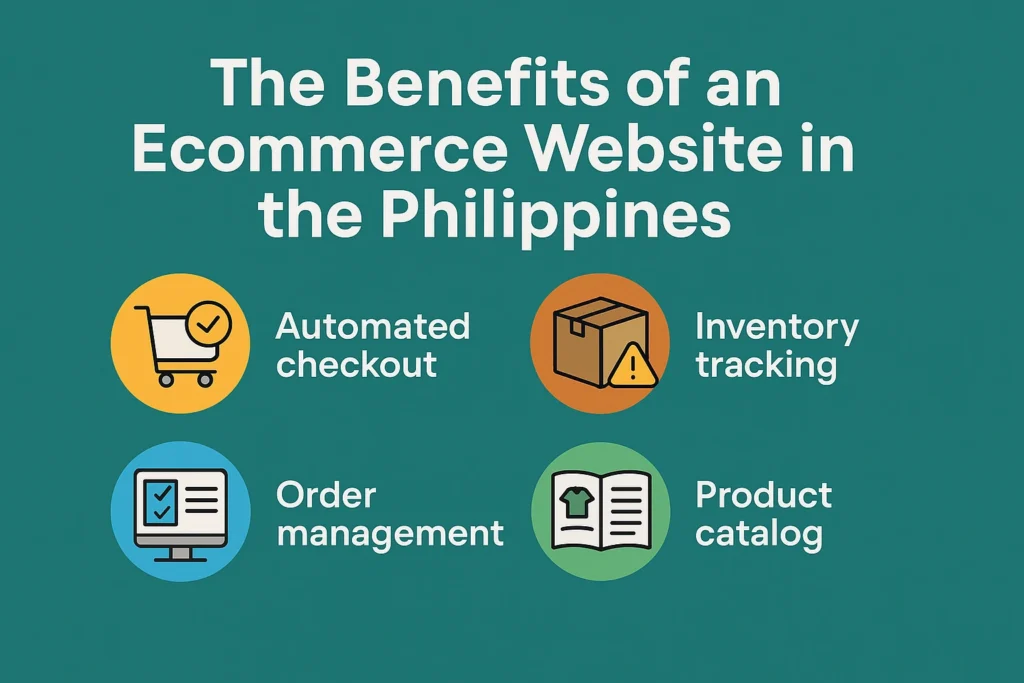
I’ve helped a few Cebu businesses get online. One client sold vintage sneakers—his whole operation was on Instagram. Once we launched his WooCommerce site, sales doubled in two months.
Why? Because people trust a real ecommerce website in the Philippines. They want to browse, compare, and check out without DM-ing anyone. They don’t want to wait. They want options. And they want clarity—fast.
Another client I worked with was running a sari-sari store just outside Mandaue. She wasn’t tech-savvy at all. But she sold frozen goods, snacks, and cleaning supplies. When the lockdowns hit, she started delivering locally using a tricycle and managed orders through Facebook Messenger. It was chaotic. Orders were missed. Payments were delayed. One day she accidentally gave the same order to two people. She felt embarrassed—and frustrated.
We helped her launch a basic ecommerce website, with a clean homepage, simple checkout, and three payment options. We kept it in Taglish, used her own product photos, and set up inventory tracking. Within the first 10 days, she had 23 online orders—from people she didn’t even know personally. The site did the talking, and the sales followed.
The beauty of online store development in the Philippines is that it doesn’t have to be expensive or complicated. You don’t need to hire a big firm or spend ₱100k. You just need a clear plan, the right tools, and a website that works on any device.
Tip: Start with a small budget. ₱15k to ₱30k is enough for a clean, working ecommerce website that’s mobile-friendly and built to grow with you. Always test it on your phone, a friend’s phone, and even your lola’s tablet. Because if a customer can’t check out in less than three steps, they’ll leave.
Another tip? Use what you already have. If you’ve been posting on Facebook or Instagram, reuse those photos. Use your most engaged posts as your homepage inspiration. Your social media is already full of content—your website just organizes it.
One more example: A local Cebu-based plant shop wanted to expand outside the city. We created an ecommerce website with regional delivery options and a simple blog about plant care. Their monthly orders jumped 300%. Why? Because people from outside Cebu wanted their products too—they just didn’t know how to order before.
Whether you’re in Cebu, Davao, Iloilo, or Tagbilaran, a good ecommerce website in the Philippines helps you grow beyond your neighborhood. It helps you reach people looking for exactly what you sell—but who’ve never heard of you until they find your site on Google.
That’s the magic. And that’s the opportunity.
Best tools to build an ecommerce website in the Philippines
“Choosing the right ecommerce platform can be the difference between a smooth sale and a missed opportunity.” Especially in the Philippines, where most buyers are using their phones, trust matters. Speed matters. And being easy to use? That’s a must for any ecommerce website in the Philippines.
Here are a few tools I’ve used when helping others sell online in Cebu and beyond:
| Platform | Best For | Price Range |
|---|---|---|
| WooCommerce | Full control & flexibility | ₱10k–₱30k (one-time setup) |
| Shopify | Beginner-friendly with apps | $19/month + transaction fees |
| Shopline | Built-in support for PH market | ₱12k–₱30k+ |
| Wix / Squarespace | Easy design for visual brands | ₱15k–₱40k (annual plans) |
Let’s break them down a little more.
WooCommerce is great if you want full control. It works with WordPress, so you can really make the design your own. One Cebu-based client used WooCommerce to set up a skincare brand. She added bundles, flash sales, and even a local delivery plugin. It took a bit more setup, but now she updates her ecommerce website weekly—without a developer.
Shopify is perfect for beginners. If you don’t want to touch code, Shopify does most of the work for you. A sneaker reseller I worked with in Cebu City chose Shopify and had his ecommerce website in the Philippines live in two days. It’s also mobile-optimized out of the box, which is huge because most Filipino shoppers are browsing and buying on phones.
Shopline is gaining traction in the Philippines. If you want a platform that offers local support and understands the PH market—especially payments and logistics—Shopline is a smart choice. I’ve seen food businesses use it to manage pre-orders and deliveries across Visayas. It’s one of the most localized options for online store development in the Philippines.
Wix and Squarespace are more visual, great for creatives and service-based businesses. If your brand is all about aesthetic—like a handmade jewelry shop or an art print studio—these can help you stand out. One designer I know used Squarespace to sell prints of her digital art. The gallery-style layout made everything look premium on her ecommerce site.
Pro tip: Don’t skimp on your domain and hosting. Seriously. A .com or .ph domain builds trust. It makes your business look real. If someone sees a link like mybusiness123.wixsite.com, they might hesitate. But something like www.cedarbakes.ph? That tells people you’re legit and that your ecommerce website in the Philippines is worth buying from.
And let’s talk hosting. Speed matters. If your ecommerce website loads too slow, people will leave before they even see your product. I tested a store once with a client—on a pocket Wi-Fi—and it took 10 seconds to load. We switched to better hosting and got it down to 3 seconds. Sales increased the next week.
If you’re on a budget, go with a local host that’s optimized for Philippine traffic. You don’t need the fanciest plan—just one that keeps your site stable and fast.
Choosing your ecommerce platform isn’t just a tech decision—it’s a growth decision. Your tools should match your vision, your budget, and your customer’s habits. If you’re selling in Cebu, Manila, or anywhere in the Philippines, start with what works. Test, improve, and grow your ecommerce website in the Philippines.
Sell online Cebu business owners: Here’s what works
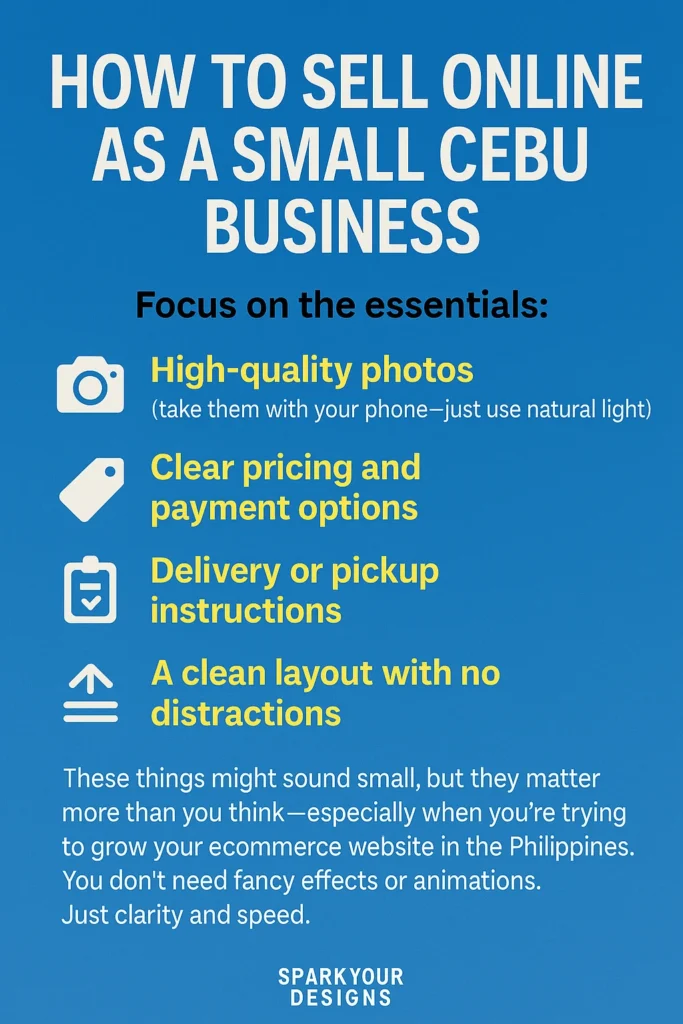
IIf you’re a small Cebu business trying to sell online, keep it simple. Focus on the stuff that matters for your ecommerce website in the Philippines:
- High-quality photos (take them with your phone—just use natural light)
- Clear pricing and multiple payment options
- Delivery or pickup instructions with clear timelines
- A clean layout with no distractions or confusing steps
These things might sound small, but they matter more than you think—especially when you’re trying to grow your ecommerce website in the Philippines. A fast-loading page with the right information builds trust. You don’t need fancy effects or animations. Just clarity and speed.
Here’s what worked for me and a client in Lapu-Lapu: we launched a pet supply store online. Within the first month, they sold out of cat treats. We didn’t even run ads—just used Facebook to link people to the ecommerce site. Because the site was mobile-friendly, had clear images, and showed stock availability, customers didn’t hesitate. They bought on the spot.
Another small Cebu business I worked with sold dried mangoes and local delicacies. Before we launched their ecommerce website, they relied purely on meet-ups and direct messages. It was hard to scale. After we built their online store, they started getting bulk orders from Manila and even overseas Filipinos sending gifts back home. A clean product page with clear shipping info changed everything.
One thing I always recommend to local businesses: highlight what makes your brand Cebuano or proudly Pinoy. Cebu-made products have strong appeal. Whether it’s baked goods, handmade bags, or island souvenirs—put that proudly on your homepage. That local charm is what sets your ecommerce website apart from big-name marketplaces.
And here’s a tip that often gets ignored: don’t clutter your pages. Many business owners feel they need to explain everything on one screen. But your ecommerce website in the Philippines should guide users naturally—from the product photo to the “Buy Now” button. Keep it lean. Keep it clear. Let your site do the selling.
Lastly, include a simple FAQ section. People want to know: How do I pay? How long does shipping take in Cebu? Can I pick up the item? What if I’m outside the city? A well-placed FAQ saves you from repetitive messages and builds instant trust.
So if you’re just starting to sell online in Cebu—or anywhere else in the Philippines—don’t stress over perfection. Focus on the essentials. Your ecommerce website should feel like your best salesperson—friendly, fast, and reliable.
For a bigger picture of the industry, you can also check out this official guide on ecommerce in the Philippines.
Building an ecommerce website in the Philippines doesn’t require coding
If you’re thinking, “But I don’t know coding,” that’s okay. Most platforms now use drag-and-drop editors. You can literally upload your product, set a price, and hit publish. Building an ecommerce website in the Philippines has never been more beginner-friendly.
I’ve guided complete beginners in Cebu—no tech background, no web design experience—who launched functional online stores in less than a week. With platforms like Shopify and Shopline, all the hard parts are taken care of. They give you templates, payment integrations, and mobile responsiveness out of the box. No code needed.
And if you feel overwhelmed, you can always get help. Many agencies (like ours) offer affordable packages to get you started without breaking the bank. We sit down with you, go over your goals, and then help build an ecommerce website that reflects your brand, speaks to your customers, and makes selling online easy.
Here’s something else: the learning curve is short. One client who runs a small Cebu-based baking business messaged me after two weeks of using her site: “I didn’t expect it to be this easy. I thought I’d mess things up, but it’s actually fun!” Her confidence grew. So did her orders.
I’ve seen businesses go from 5 orders a week to 50—all because their ecommerce site made it easy to buy. It doesn’t have to be perfect at the start. It just needs to work. Then you tweak, improve, and grow.
If budget is a concern, we break it down clearly in our guide on website design cost in the Philippines.
Ready to build your ecommerce website in the Philippines?
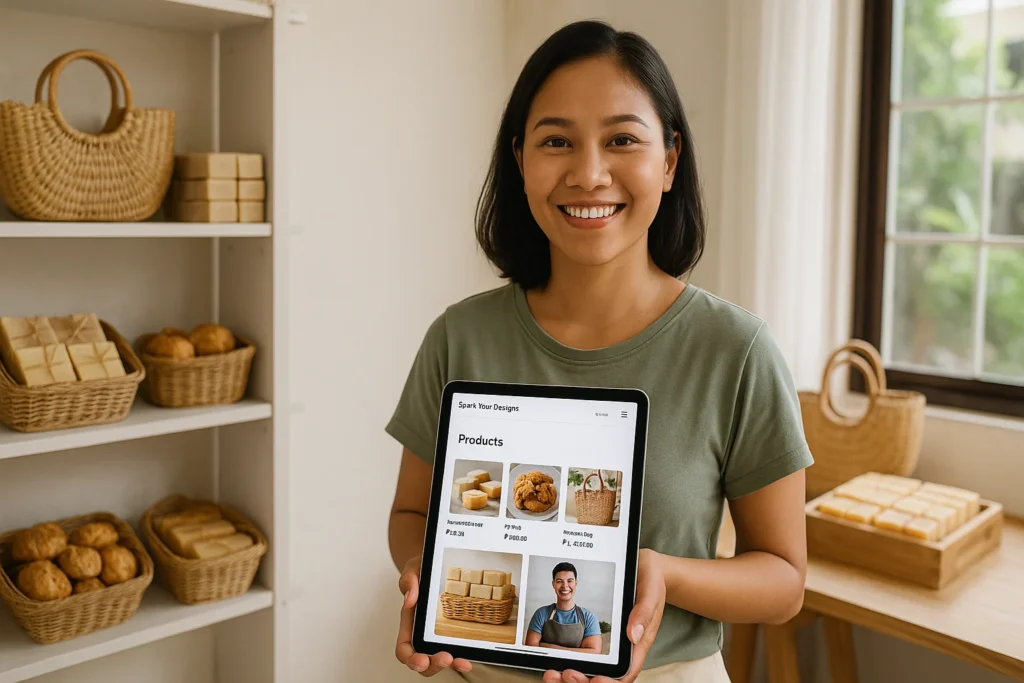
If you’re ready to launch your own ecommerce website in the Philippines, don’t overthink it. Just start.
Pick a platform that fits your budget and your business goals. Write simple product descriptions. Focus on the basics that matter for online store development in the Philippines—easy checkout, clear photos, and mobile-friendly design.
Need help building a site that sells? Let’s get started and build something great together. We specialize in helping small businesses in Cebu and across the Philippines get their ecommerce websites up and running.
Still thinking? Learn what’s possible for your brand by reading our insights on small business website design in Cebu.



